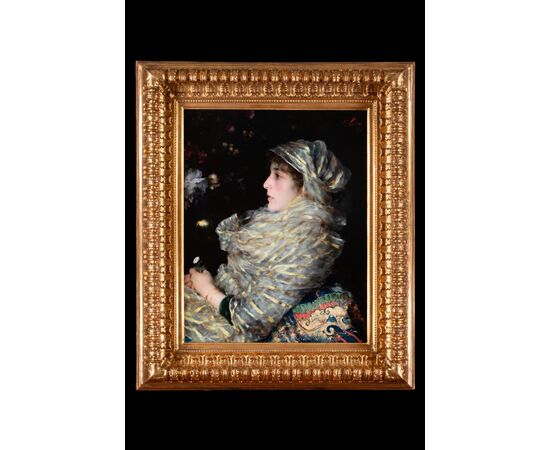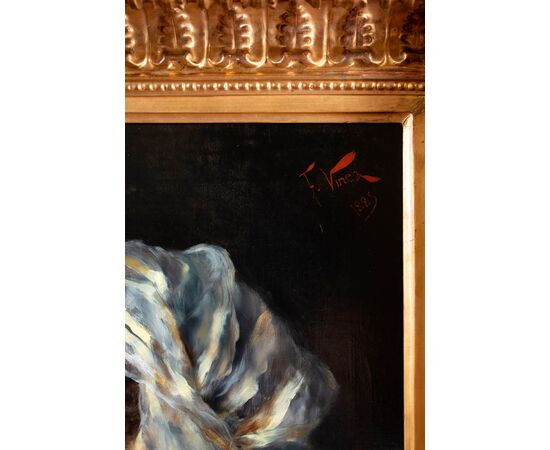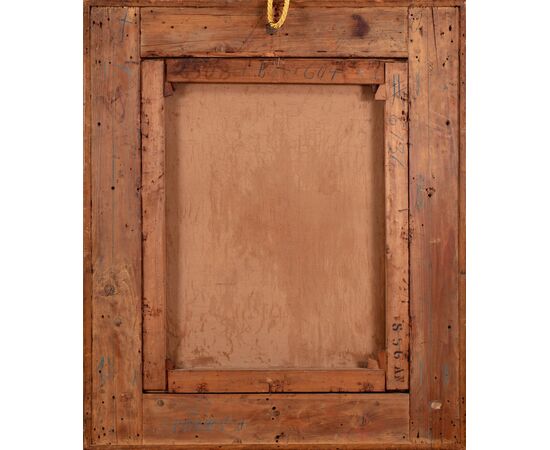Francesco Vinea (Forlì 1845 - Florence 1902), "Sehnsucht," 1885
Francesco Vinea (Forlì 1845 - Florence 1902), "Sehnsucht," 1885
Oil on canvas, 74 x 58 cm
Signed "F. Vinea /1885" at the top right
The painting depicts a young woman in profile; the brightness of the clothes stands out against a dark background of foliage and dark inflorescences, highlighting the figure.
The title of the work, "Sehnsucht," refers to a concept of German Romanticism, not translatable into our language, but whose meaning is close to the word "longing." The word Sehnsucht, composed of das Sehnen, ardent desire, and die Sucht, that is, addiction, can be understood as a desire for desire, a painful and violent yearning for something indefinite that one has no hope of obtaining.
Sehnsucht has been a source of inspiration for artists and writers, such as the writer and poet Friedrich Schiller and the composer Franz Schubert. We do not know if this was the title chosen by Vinea, as it was derived from an 1887 engraving attributed to the wood engraver and painter Alfredo Zanoboni.
The girl's gaze appears stunned, fixed on an indefinite point, beyond the border of the frame; her lips are parted, her cheeks rosy, and her eyes bright and glassy.
The hands joined on her lap clutch a pure white chrysanthemum, a delicate flower that blooms in November, perhaps a symbol of devoted love.
The bust and head are wrapped in a long shawl decorated with golden stripes, from which the sleeve of a green velvet dress peeps out at the wrist; the artist demonstrates a refined executive technique in rendering the transparencies given by the overlapping of fabrics and in the play of light created by the gold.
The young woman ardently hopes for the return of her beloved, but she does not know if her desire can be fulfilled. She sighs melancholically, Sehnsucht pervades her.
As for the technique, the painter uses a mixed brushstroke: textured and filamentous in the rendering of the scarf's fibers, more harmonious and uniform for the complexion.
The painting is full of sentimentality, differs from the light pictures for which Vinea is best known, and a decidedly more personal, reflective, and profound imprint of the artist emerges.
BIOGRAPHY
Francesco Vinea was born in Forlì in 1845 to a family of modest origins; his initial education was troubled and discontinuous. The boy's aptitude for drawing was immediately evident, and at the age of only 14, he moved to Florence to enroll in the city's Academy of Fine Arts. At the institution, he attended lessons by the painter Enrico Pollastrini (1812 - 1876), briefly approaching romantic poetics. He made his debut at the National Exhibition of Florence in 1861 with Female Portrait, a painting that suggests his interest in the study of the female nude. Later, he dedicated himself to historical painting, preferring genre scenes in costume, with worldly and light themes, without giving up commissions of a more solemn character in the wake of Jean Louis E. Meissonier; as early as 1863, he painted Michelangelo Reciting His Verses to Vittoria Colonna for the royal apartments of Palazzo Pitti.
Due to significant economic difficulties, the young Vinea was forced to interrupt his studies and undertake a working activity that guaranteed him a stable salary, approaching the world of photography and illustration. The job allowed him to develop skills in rendering details and study Italian painting of the 18th century in depth.
During his intense career, he participated in countless national and European exhibitions, where his historical reconstructions, imbued with a cheerful atmosphere and bright colors, were highly sought after by various art dealers, including the famous Adolphe Goupil and Luigi Pisani. The widespread success found in France, England, and Germany guaranteed him a comfortable existence, as demonstrated by the purchase of a summer residence in Pracchia, on the Pistoia Apennines. At his studio in Viale Principe Eugenio, Vinea worked incessantly and tirelessly on his luminously palette and sophisticated material rendition of works, whose subjects, adapted to the taste of international collectors, are represented with festive elegance and amiable frivolity.
The artist ranges from genre scenes such as Breakfast in the Countryside or Wedding Cortège to historical works such as Musketeers and Before the Duel (now at the GAM in Milan), also dedicating himself to graceful female nudes, such as A Lone Bather and Odalisque.
The paintings of charming young women are very appreciated, often immersed in flowered gardens or graceful indoor scenes and depicted while sipping tea, dedicated to romantic readings, or strolling in the park with their pets. Among these works, we remember Young Woman in the Garden, The Cup of Coffee, The Tea Time. Despite the almost exclusively decorative character of his work, Vinea represents one of the most significant examples of late 19th-century genre painting, perfectly embodying the bourgeois spirit of his era. He died at the height of his career in 1902 in Florence, at only fifty-seven years old.






